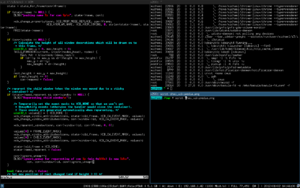i3 (window manager)
 | |
 i3 with vim and terminals open | |
| Original author(s) | Michael Stapelberg |
|---|---|
| Initial release | March 15, 2009[1] |
| Stable release | 4.23[2] |
| Repository | |
| Written in | C |
| Operating system | Unix-like |
| Size | 1.3 MiB[3] |
| Type | Window manager |
| License | BSD-3-Clause[4] |
| Website | i3wm.org |
i3 is a
Like wmii, i3 uses a control system very similar to that of vi and Vim. By default, window focus is controlled by what the documentation refers to as the 'Mod1' key (Alt key/Windows key) in addition to the right-hand home row keys (Mod1+J,K,L,Semicolon), while window movement is controlled by the addition of the Shift key (Mod1+Shift+J,K,L,Semicolon).[7]
Design goals
i3's primary design goals are to possess well-written, documented code that encourages user contribution;[4] to use XCB instead of Xlib; to implement multi-monitor features correctly, so that each workspace is assigned to a virtual screen, and monitor additions and removals are non-destructive of windows; to implement different modes, in a manner similar to that of the text editors vi and vim; to use a tree as the abstraction (and underlying data structure) for window management; and to implement UTF-8 character encoding.
Features
i3's configuration is done via a
i3 also supports the use of multiple monitors.[10]
Floating pop-up windows
Even though i3 is a tiling window manager, specific windows, such as password pop-ups, are not displayed as new tiles by default;[11] they are always stacked in front of tiled windows, unless in full screen mode. These floating windows can be moved and resized freely, just as they can in stacking window managers and popular desktop environments like GNOME or KDE Plasma.[8]
The authors of i3 intend floating windows to be used for pop-up windows only.[12]
Gallery
-
i3 with stacked layout
-
i3 with tabbed layout
-
i3 with floating window
See also
- Comparison of X window managers
- Waylandthat is similar to i3
References
- ^ GitHub releases
- ^ "Release 4.23". 29 October 2023. Retrieved 18 November 2023.
- ^ i3 download page
- ^ a b i3 home page
- ^ i3 - An Improved Tiling Window Manager
- ^ Stapelberg, Michael. "i3: IPC interface (interprocess communication)".
- ^ a b c Congleton, Nick (May 23, 2017). "Install and Use i3 Window Manager on Ubuntu". maketecheasier. Uqnic Network Pte. Retrieved May 1, 2019.
- ^ a b J.A. Watson (January 7, 2016). "How to customise your Linux desktop: i3 Window Manager". zdnet.com. ZDNet. Retrieved May 1, 2019.
- ^ "Getting started with the i3 tiling window manager". 24 February 2016.
- ^ "Using i3 with multiple monitors".
- ^ Stapelberg, Michael. "Forcing windows as always floating".
- ^ Stapelberg, Michael. ""floating" workspace".
Footnotes
- ^ In Unix filesystems, "~" refers to the user's home directory.



